
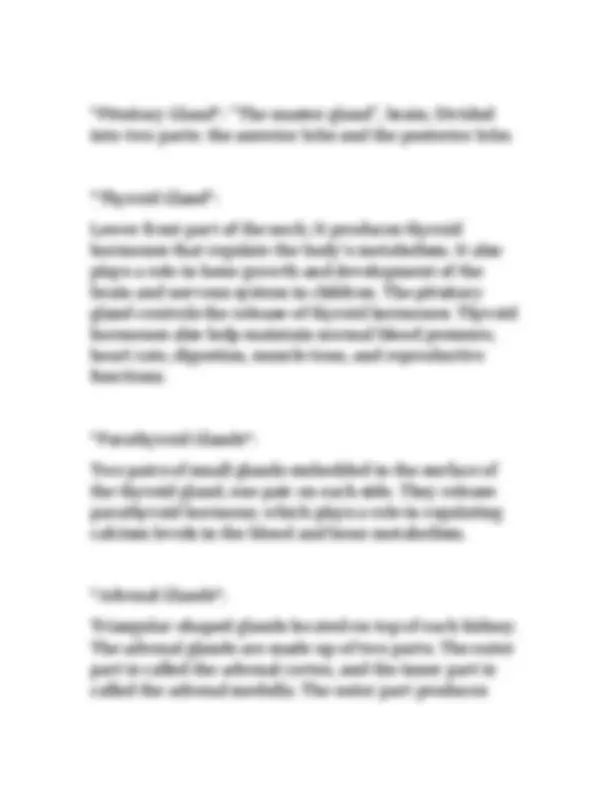
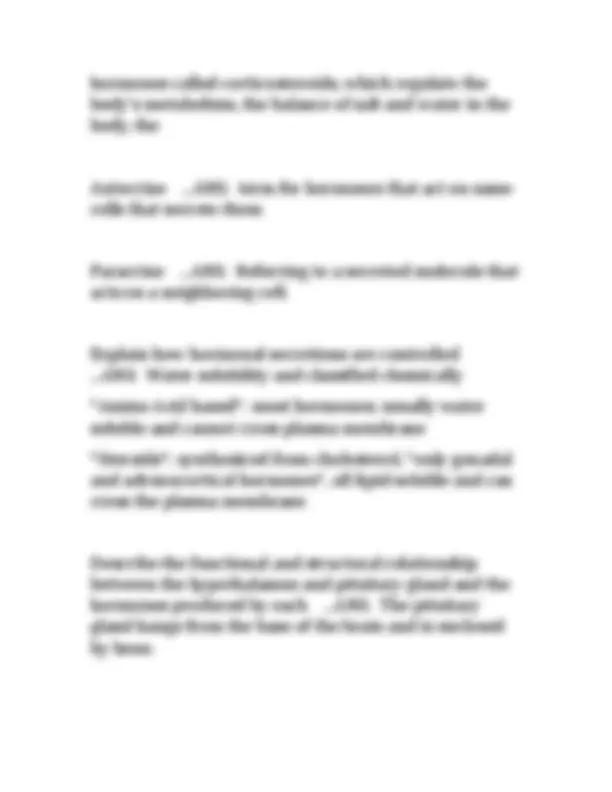
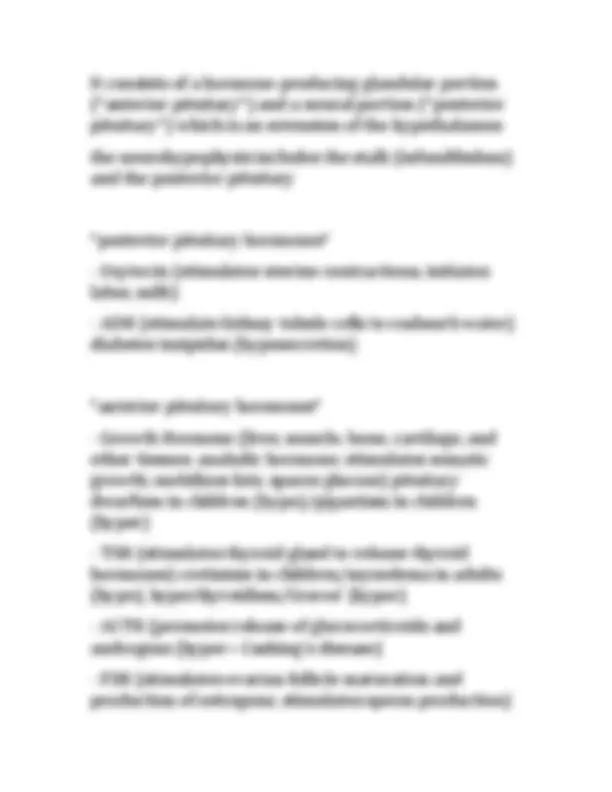
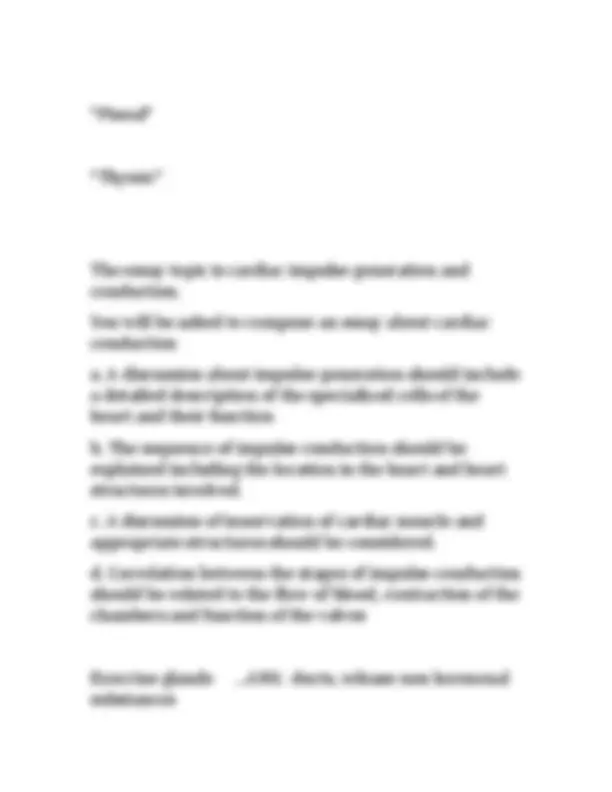
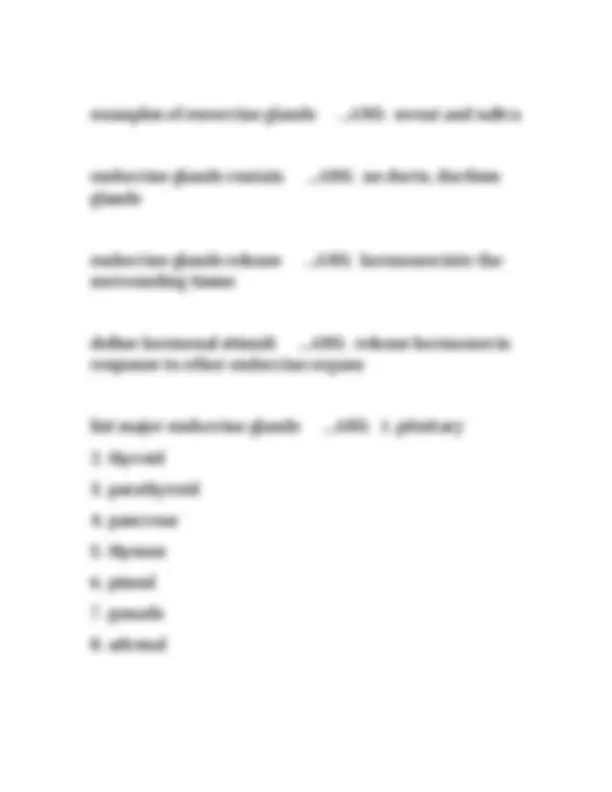
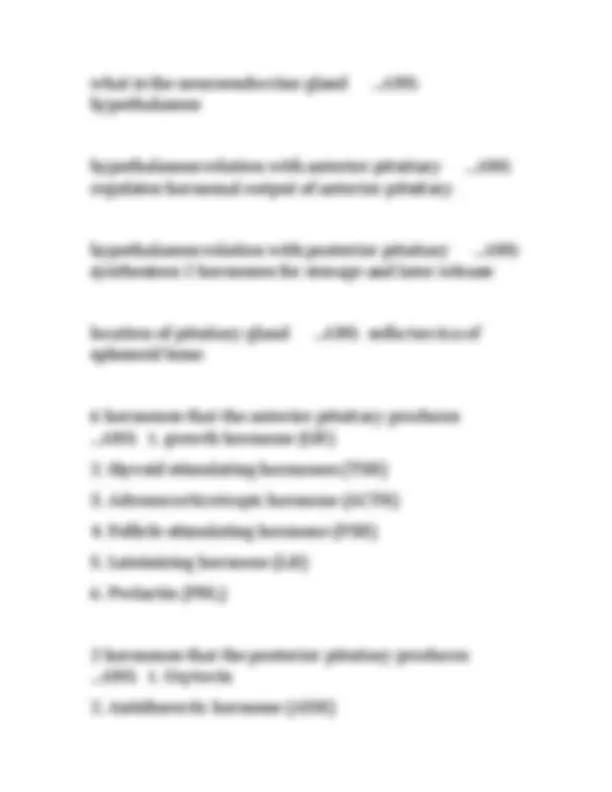
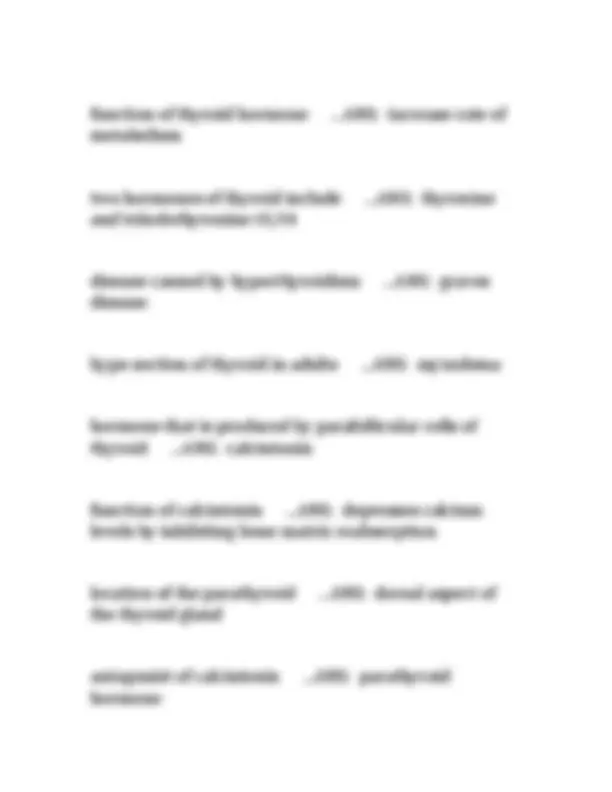
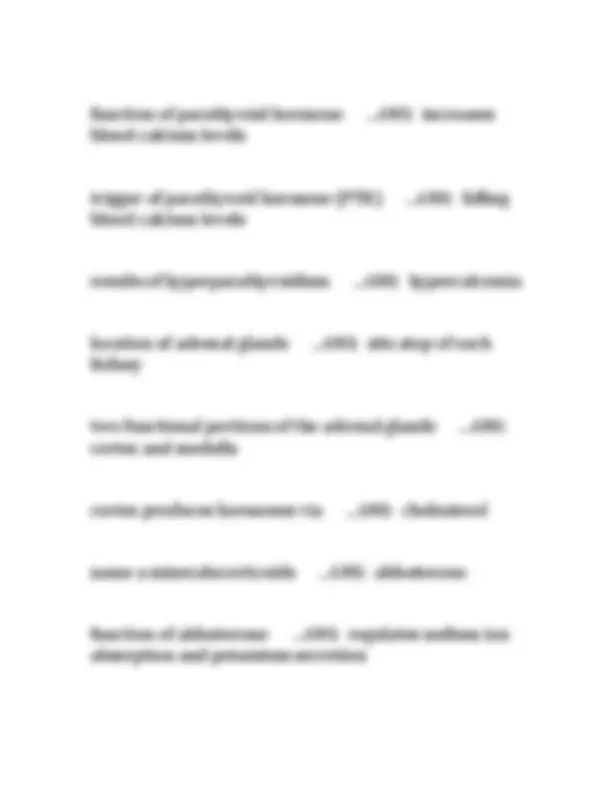
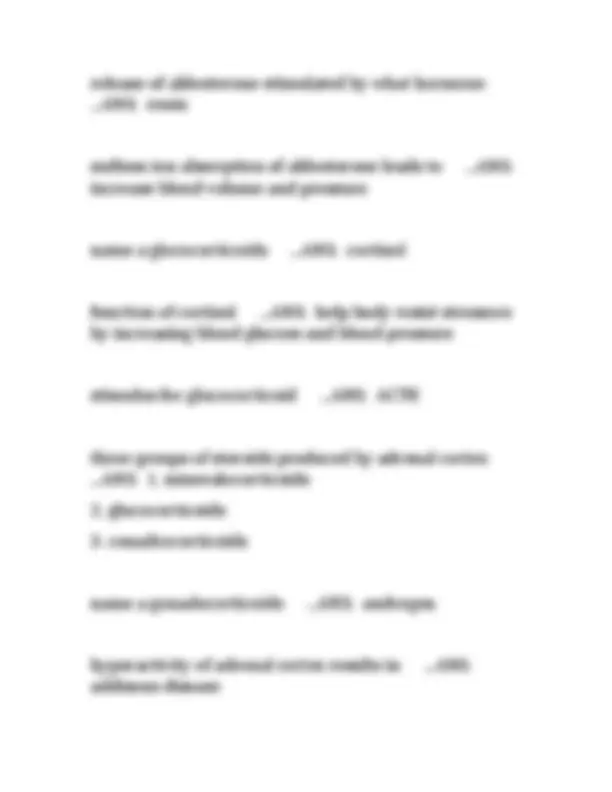
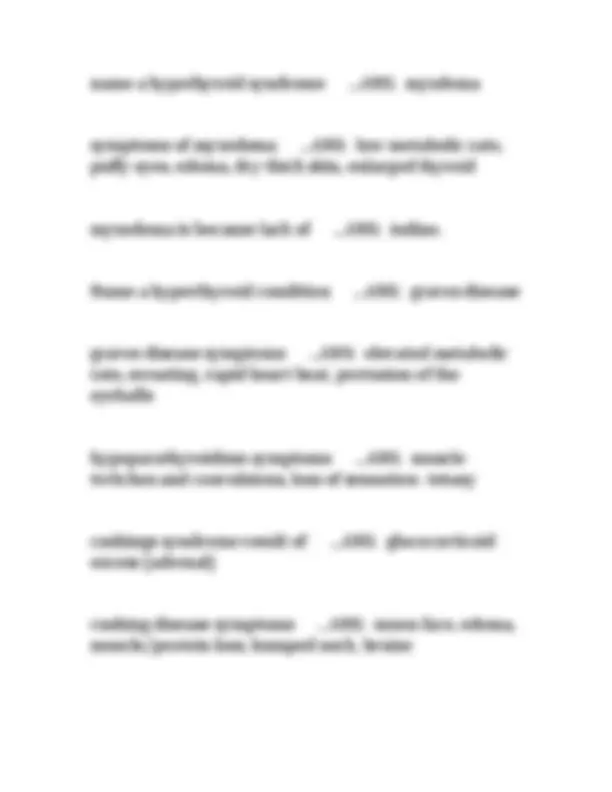
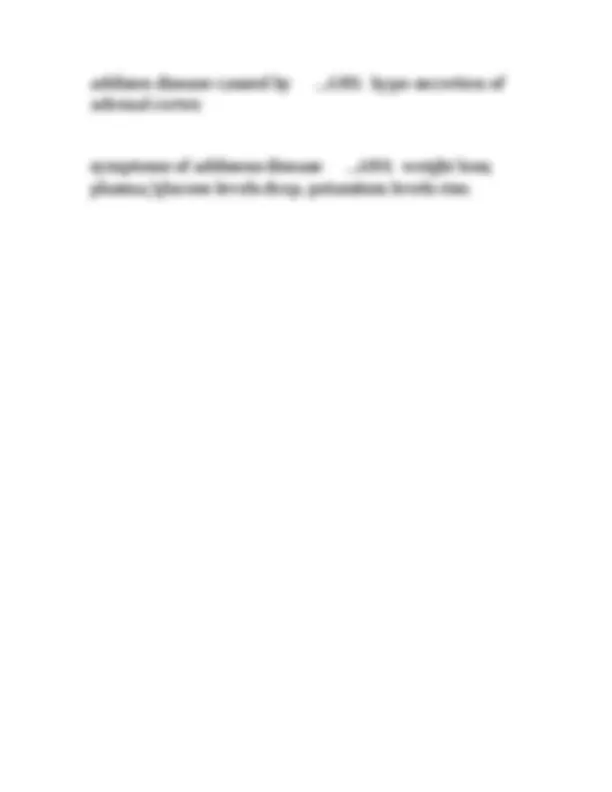


Study with the several resources on Docsity

Earn points by helping other students or get them with a premium plan


Prepare for your exams
Study with the several resources on Docsity

Earn points to download
Earn points by helping other students or get them with a premium plan
Community
Ask the community for help and clear up your study doubts
Discover the best universities in your country according to Docsity users
Free resources
Download our free guides on studying techniques, anxiety management strategies, and thesis advice from Docsity tutors
Compare and contrast endocrine and exocrine glands ...ANS: Endocrine: - secretes hormones - secretes into interstitial fluid and intervascular fluid - also called "ductless glands" - ex: thyroid gland, pituitary gland Exocrine: - discharged onto epithelial surface - secretions reach surface through tubular ducts - ex: perspiration, tears in eyes, mammary glands Compare and contrast hormonal and neural controls of body functioning ...ANS: nervous system exerts rapid controls via nerve impulses endocrine exerts more prolonged effects via hormones
Typology: Exams
1 / 19

This page cannot be seen from the preview
Don't miss anything!












Compare and contrast endocrine and exocrine glands ...ANS: Endocrine:
Neural: controls and coordinates activities of cells, moves nerve impulse down the length of a cell through neuron, high speed and shorter duration of action Hormonal: chemical impulses, releases chemicals into bloodstream (hormones) into blood to circulate through systemic circulation to act on target cells, longer duration of activation, much slower List the major endocrine organs and their location in the body ...ANS: pituitary, thyroid, parathyroid, adrenal, and pineal glands
hormones called corticosteroids, which regulate the body's metabolism, the balance of salt and water in the body, the Autocrine ...ANS: term for hormones that act on same cells that secrete them Paracrine ...ANS: Referring to a secreted molecule that acts on a neighboring cell. Explain how hormonal secretions are controlled ...ANS: Water solubility and classified chemically Amino Acid based: most hormones; usually water soluble and cannot cross plasma membrane Steroids: synthesized from cholesterol, only gonadal and adrenocortical hormones, all lipid soluble and can cross the plasma membrane Describe the functional and structural relationship between the hypothalamus and pituitary gland and the hormones produced by each ...ANS: The pituitary gland hangs from the base of the brain and is enclosed by bone.
It consists of a hormone-producing glandular portion (anterior pituitary) and a neural portion (posterior pituitary) which is an extension of the hypothalamus the neurohypophysis includes the stalk (infundibulum) and the posterior pituitary posterior pituitary hormones
Compare and contrast circulating and local hormones. ...ANS: Describe the site production, actions, and regulation of hormones produced at the following sites and describe pathologic states associated with each: Thyroid Parathyroid Adrenal Pancreatic Gonads Pineal Thymic ...ANS: Thyroid: basal metabolic rate(BMR)/temp regulation Parathyroid Adrenal Pancreatic Gonads
Pineal Thymic The essay topic is cardiac impulse generation and conduction. You will be asked to compose an essay about cardiac conduction a. A discussion about impulse generation should include a detailed description of the specialized cells of the heart and their function b. The sequence of impulse conduction should be explained including the location in the heart and heart structures involved. c. A discussion of innervation of cardiac muscle and appropriate structures should be considered. d. Correlation between the stages of impulse conduction should be related to the flow of blood, contraction of the chambers and function of the valves Exocrine glands ...ANS: ducts, release non hormonal substances
what is the neuroendocrine gland ...ANS: hypothalamus hypothalamus relation with anterior pituitary ...ANS: regulates hormonal output of anterior pituitary hypothalamus relation with posterior pituitary ...ANS: synthesizes 2 hormones for storage and later release location of pituitary gland ...ANS: sella turcica of sphenoid bone 6 hormones that the anterior pituitary produces ...ANS: 1. growth hormone (GH)
Posterior pituitary hormones are produced by ...ANS: the hypothalamus but stored in posterior pituitary gland growth hormone stimulates ...ANS: body cells to increase in size growth hormone stimulated by ...ANS: IGH (insulin growth factors) - AKA somatomedin thyroid stimulating hormone function ...ANS: promotes normal development and activity of the thyroid gland what stimulates the release of TSH? ...ANS: thyrotropin function of ACTH ...ANS: stimulates the adrenal cortex to release corticosteroids what stimulates the release of ACTH? ...ANS: corticotropin releasing hormone (CRH)
function of thyroid hormone ...ANS: increase rate of metabolism two hormones of thyroid include ...ANS: thyroxine and triiodothyronine t3/t disease caused by hyperthyroidism ...ANS: graves disease hypo section of thyroid in adults ...ANS: myxedema hormone that is produced by parafollicular cells of thyroid ...ANS: calcintonin function of calcintonin ...ANS: depresses calcium levels by inhibiting bone matrix reabsorption location of the parathyroid ...ANS: dorsal aspect of the thyroid gland antagonist of calcintonin ...ANS: parathyroid hormone
function of parathyroid hormone ...ANS: increases blood calcium levels trigger of parathyroid hormone (PTH) ...ANS: falling blood calcium levels results of hyperparathyroidism ...ANS: hypercalcemia location of adrenal glands ...ANS: sits atop of each kidney two functional portions of the adrenal glands ...ANS: cortex and medulla cortex produces hormones via ...ANS: cholesterol name a mineralocorticoids ...ANS: aldosterone function of aldosterone ...ANS: regulates sodium ion absorption and potassium secretion
hyper secretion of adrenal cortex results in 3 diseases ...ANS: aldosteronisms, cushing's syndrome and adrenogenital syndrome what does adrenal medulla produce? ...ANS: catecholamines (epinephrine and norephinephrine) location of the pancreas ...ANS: abdomen close to the stomach endocrine portion of the pancreas releases ...ANS: insulin and glucagon pancreas is known as both the ...ANS: endocrine and exocrine gland glucagon is released by ...ANS: alpha cells, increases blood levels insulin is released by ...ANS: beta cells, decrease in blood levels
pineal gland is located ...ANS: diencephalon pineal gland secretes ...ANS: melantonin thymus located ...ANS: upper thorax function of thymus ...ANS: development of immune respone 2 hormones the thymus produce ...ANS: thymosin and thymopoeitins imbalance of GH disease ...ANS: acromegaly define acromegaly ...ANS: enlarged extremities, hands feet and face imbalance of ADH causes ...ANS: diabetes insipidus define diabetes insipidus ...ANS: huge output or urine and intense thirst
addison disease caused by ...ANS: hypo secretion of adrenal cortex symptoms of addisons disease ...ANS: weight loss, plasma/glucose levels drop, potassium levels rise.